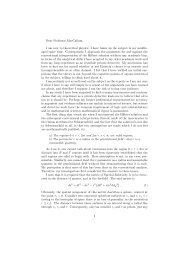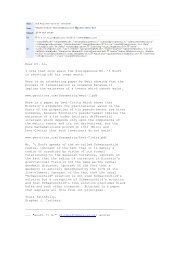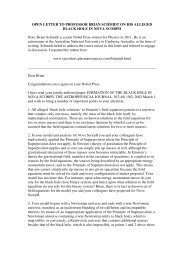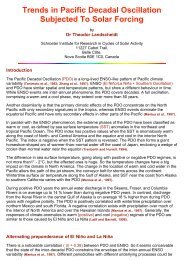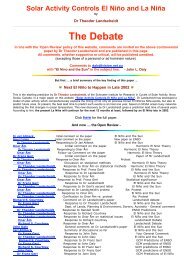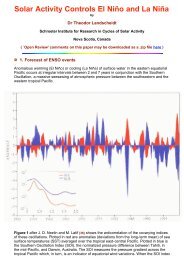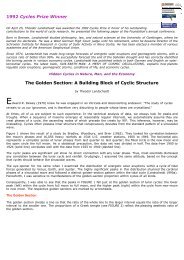Sun-Earth-Man - PlasmaResources
Sun-Earth-Man - PlasmaResources
Sun-Earth-Man - PlasmaResources
Create successful ePaper yourself
Turn your PDF publications into a flip-book with our unique Google optimized e-Paper software.
IN-EARTH-MAN. A MESH OFCOSMICOSCILLATIONS<br />
Figure 23: Smoothed running variance V of the <strong>Sun</strong>'s equatorial angular sidereal rotation rate (Mount W&* data)<br />
covering Carrington rotat~ons 1516 (December 29.1%) to 1726 (September 4.1982). Fat arrows point ~OW-CM-CS~<br />
epochs (C), while a hiangle marks the epoch of a JU-CM-CSg event (G). Arrow-heads designare harmonics dquasi.<br />
cycles formed by mnsecutive JU-CM-CS events.<br />
of the variance cover two consecutive rotations, thus measuring the variation<br />
in variability from one rotation to the next one. These results have been<br />
subjected to a Gaussian low-pass filter eliminating short range features<br />
covering less than five rotations. The ordinate axis measures this smoothed<br />
running variance. The epochs of JU-CM-CS events in 1967.8 and 1974.48 are<br />
marked by fat arrows and the letter C, whereas the epoch of the event in<br />
1970.02 is indicated by a fat triangle and the le!ter G. This makes allowance<br />
for the two types of JU-CM-CS events mentioned already: those that go along<br />
with an increase in orbital momentum and resulting centrifugal motion of the<br />
<strong>Sun</strong> (C), and those that initiate a decrease in orbital momentum and centripetal<br />
motion due to prevailing gravitation (G).<br />
The two C-conjunctions are related to prominent variance peaks significant<br />
at the 85% confidence level (CL) and far beyond. If the running variance is<br />
not subjected to smoothing, the second C-peak in 1974 reaches the 95%<br />
confidence level. There is only a relatively small variance peak connected with<br />
the G-conjunction in 1970. This points to a different quality of this kind of<br />
events, which was to be expected, as the orbital momentum does not increase,<br />
but is diminished. Nevertheless, G-conjunctions, too, have an impact on the<br />
<strong>Sun</strong>'s differential rotation. The Mount Wilson rotation data do not cover the<br />
following C-conjunction in 1982.8. It is beyond the kame of the plot. If<br />
consecutive conjunctions are thought to form quasi-cycles initiated by the



